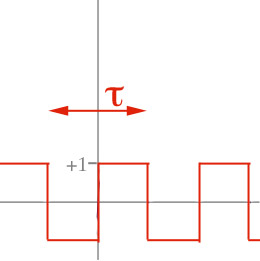Fourier series
Periodic functions
A function which repeats with "period" $\tau$: $$f(t+\tau) = f(t)$$

The sine and cosine function are periodic. In fact, there are a bunch of different ones that all have the same period:

The angular frequency, the number of "radians per second" can be expressed as $\omega=2\pi/\tau$ in terms of the period. You should convince yourself that all of these functions share a common period $\tau$: $\cos(n\omega t)$ and $\sin(n\omega t)$ where [n=0,1,2,...]
The constant function, $f(t)=C$, is periodic for all values of $\tau$>, because $f(t+\tau)=f(t)=C$. We might perversely write this as a cosine function with $\omega=0$: $$f(t)=C\cos(0 t).$$
An amazing discovery
... by Jean Baptiste Fourier (1768-1830) was that any possible periodic function can be written as a linear combination of the sine and cosine functions above:
$$f(t) = a_0 +\sum_{n=1}^{\infty}[a_n \cos (n\omega t) + b_n \sin (n\omega t)]$$
I could, somewhat perversely, write this as $$f(t) = a_0\cos(0\omega t) +\sum_{n=1}^{\infty}[a_n \cos (n\omega t) + b_n \sin (n\omega t)]$$ to emphasize the connection of all the terms to particular functions of sine and cosine.
The coefficients ($n>0$) are given by: $$a_n=\frac{2}{\tau}\int_{-\tau/2}^{\tau/2} f(t) \cos (n\omega t) \,dt,$$ $$b_n=\frac{2}{\tau}\int_{-\tau/2}^{\tau/2} f(t) \sin (n\omega t)\,dt,$$ and $$a_0 = \frac{1}{\tau} \int_{-\tau/2}^{\tau/2} f(t) \,dt = \langle f \rangle.$$ $a_0$ is the average value of the function, over one period of oscillation.
Fourier components of a square wave
 We'd like to find the fourier coefficients for the square wave $f(t)$ pictured
at right, where
We'd like to find the fourier coefficients for the square wave $f(t)$ pictured
at right, where
$f(t)= +1$ for $0 < t < \tau/2$
$f(t)=-1$ for $-\tau/2 < t < 0$
The average value of the function over one period is 0, $$\Rightarrow a_0=0.$$
The cosine coefficients are: $$a_n=\frac{2}{\tau}\int_{-\tau/2}^{\tau/2} f(t) \cos (n\omega t) \,dt$$ Note that:
- $f(t)$ is an odd function, that is, $f(-t)=-f(t)$
- But the cosine is even, that is, $\cos(n\omega (-t)) =\cos(n\omega t)$,
- The product of an even function and and odd function is an odd function.
- The integral of an odd function over an even interval is zero.
The sine coefficients are: $$ b_n=\frac{2}{\tau}\int_{-\tau/2}^{\tau/2} f(t) \sin (n\omega t)\,dt.$$
- Both $\sin(n\omega t)$ and $f(t)$ are odd in $t$.
- An odd times an odd function = even function.
- An even function integrated over the even interval $[-\tau/2,+\tau/2]$, is twice the function integrated over the interval $[0,+\tau/2]$.
- $\omega = \frac{2\pi}{\tau}$, so $\omega\tau = 2\pi$.
So, the fourier series for $f(t)$ should be $$f(t) = +\frac{4}{\pi}[\sin(\omega t) +\frac{1}{3}\sin(3\omega t)+\frac{1}{5}\sin(5\omega t)+\frac{1}{7}\sin(7\omega t)+...]$$
The graph shows $f(t)$ with successively more of the terms above, and shifted vertically (except for the lowest graph) so as to see each function separately.
one term,
three terms,
5 terms,
11 terms.
Homework
Chapter 5: 47